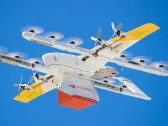The futuristic idea of delivering food to your doorstep from a drone has become a reality with the launch of Wing, a project by Alphabet (Google). This innovative service, known as Project Wing, aims to revolutionize the way we receive our meals. Let’s dive into how this groundbreaking technology works, its current status, and its potential future.
How Wing Works
Technical Specifications
The Wing drones are designed with advanced propulsion systems that allow them to fly at speeds of up to 20 mph (32 km/h). These drones can carry payloads ranging from 16 oz (454 grams) to 8 lb (3.6 kg), making them capable of delivering a variety of items, including food and packages.
Key Features
- Wing 2.0: The latest iteration of the drone includes an improved navigation system that ensures precision delivery within a 10 ft x 10 ft (3m x 3m) area.
- AI-Powered Flight Control: Advanced AI algorithms allow the drones to avoid obstacles and follow precise routes, even in urban environments.
- Battery Life: The drones are equipped with lithium-ion batteries that last up to 4 hours on a single charge.
Operation Process
- Order Placement: Customers place their orders through Wing’s app or website.
- Preparation: Once an order is placed, the meal is prepared at a local kitchen and loaded onto a Wing drone.
- Delivery: The drone navigates to the customer’s address, maintaining precise flight paths to ensure food remains fresh upon arrival.
Current Status and Impact
Key Partnerships
- Deliveroo Integration: Wing works closely with Deliveroo, a well-known food delivery platform in the U.K., allowing customers to order popular dishes directly through the app.
- Walmart Footprint: Walmart’s extensive distribution network ensures reliable last-mile delivery, complementing Wing’s drone capabilities.
Market Presence
As of now, Wing drones are operational in several U.S. cities, including New York, Los Angeles, and Chicago. The company is expanding rapidly to cover more urban areas, aiming to establish itself as a leading player in the food delivery sector.
Business Model
Revenue Streams
- Meal Delivery: Wing generates revenue primarily through meal deliveries, with partnerships like Deliveroo and Walmart providing this service.
- Fare Collection: In addition to meal delivery, Wing is exploring fare collection models for taxi rides and other transportation services.
Pricing Strategy
Wing’s pricing model is designed to be competitive while ensuring profitability. Customers can choose from various price tiers based on the size of their order or the distance of the delivery.
Future Vision
Wing’s vision extends beyond food delivery: The company aims to integrate drone technology into other areas, such as package delivery and retail. By 2035, Wing plans to establish itself as a leading player in the drone delivery sector nationwide.
Sustainability Goals
Alphabet is committed to reducing its environmental impact. Wing’s drones are designed to minimize carbon emissions while ensuring efficient delivery routes. The company is also exploring ways to reuse packaging materials and reduce operational costs.
Financial Considerations
Investment Stories
- Founders: John Doel, a hardware engineer at Alphabet, founded Project Wing in 2014. He later became the chief technology officer before assuming the role of CEO in 2022.
- Funding: Wing has attracted significant investment from venture capital firms like ZEBOX Ventures and X Development. However, it is yet to raise additional funds, which analysts believe could indicate that the company is part of a broader vision at Google.
Analyst Opinions
- Positive Outlook: Analysts predict that Wing’s efforts will contribute significantly to Alphabet’s broader transportation vision. They anticipate further investment in the next round, signaling confidence in the company’s growth potential.
- Market Impact: With an estimated market size of $830 million this year and a projected growth rate of 12% annually, Wing has the potential to become one of the largest drone delivery companies globally.
The Road Ahead
While Wing has made remarkable strides in developing its technology, challenges remain. Regulatory approvals for urban areas are still pending, and scaling operations across multiple regions will require significant logistical planning. However, with its innovative approach and strong partnerships, Wing is poised to disrupt the food delivery industry as we know it.
As wing continues to grow, it will undoubtedly play a pivotal role in shaping the future of transportation and meal delivery services.
